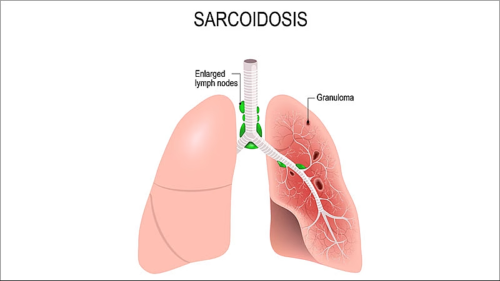Sarcoidosis sounds like a scary word that you don’t hear too often. It is a condition that affects as many as a million people around the world — including big celeb names like boxer Evander Holyfield, songstress Angie Stone, TV Judge Joe Brown, and actress Tisha Campbell-Martin. Actor and comedian Bernie Mac lived with sarcoidosis for 25 years and even set up a foundation to help inform patients.
What is sarcoidosis?
Sarcoidosis is an inflammatory disease that affects one or more organs but most commonly the lungs and lymph glands. The inflammation causes abnormal lumps or nodules (granulomas) to form in one or more organs of the body. The granulomas may change the normal structure and possibly the function of the organ that is affected. Sarcoidosis is not contagious. This means you can’t catch sarcoidosis from another person who has the disease. Cigarette smokers are also not at an increased risk of developing it.
What causes it?
The exact cause of sarcoidosis is still pretty much unknown. It can just spring up suddenly and then just disappear. Its symptoms can also just come and go as well over the years. Some clinicians believe that the disease is brought on by an abnormal immune response. In a healthy person, for example, inflammation occurs as the cells of the body’s immune system come together to battle the intruder at an organ or tissue site. In a person who has the condition, cells that come to fight wind up sort of clumping together into small lumps and these are what is referred to as granulomas.
The most common areas of the body that are affected by the disease are the lymph nodes, spleen, lungs, eyes, skin, liver, heart, and brain. The lungs are most affected in 90 percent of cases. As far as which kinds of foreign invaders trigger the body’s abnormal response is what researchers find puzzling–fungi, viruses, chemicals (insecticides), environmental (like exposure to mold), or bacteria are probably the likely culprits.
Who is most likely to develop it?
Race, gender, and genetics increase the risk of developing the condition. Sarcoidosis is more common in women than in men. African-Americans are 3 times more likely than whites to develop sarcoidosis.
African-American women are the most commonly affected group with nearly a 3 percent lifetime risk for developing sarcoidosis. In African-Americans, the condition also tends to be chronic, involve several organs, and can lead to death.
If a relative has sarcoidosis, a family member is at a higher risk of developing it compared to the general population. However, while family members are at higher risk, less than 1 percent of first-degree (parent, sibling, child), and second-degree relatives (grandparents, aunts, uncles) of sarcoidosis patients develop the disease.
How is it diagnosed and what are the symptoms?
Diagnosing sarcoidosis can be difficult. Someone with sarcoidosis may not have any symptoms at all, yet it is often discovered during a routine checkup. On the other hand, symptoms can be similar to those of other diseases, such as arthritis or cancer. Your doctor will run a variety of tests to make a diagnosis. The disease is most often detected by a chest x-ray or chest CT scan, which most commonly shows enlarged lymph nodes and granulomas.
General symptoms, however, may include:
- Fatigue
- Fever
- Weight loss
- Joint pain
- Abdominal swelling
- Dry mouth
- Nosebleeds
Lung symptoms may include:
- Persistent dry cough
- Shortness of breath
- Wheezing
- Chest pain
Skin symptoms may include:
- Reddish bumps on the shins, ankles which may be tender when touched
- Lesions on nose, cheeks, ears
- Areas of skin that vary in color (light/dark)
- Growths under the skin (nodules) around scars or tattoos
Eye symptoms may include:
- Blurred vision
- Eye pain
- Severe redness
- Sensitivity to light
Heart symptoms may include:
- Chest pain
- Shortness of breath
- Fainting
- Fatigue
- Irregular heartbeats
- Palpitations
- Edema
Treatment/Medications
The outlook for people living with sarcoidosis is generally good. There is no cure for sarcoidosis but in half of the cases, symptoms will often improve with or without treatment. A medical provider, however, will want to monitor a sarcoidosis patient with routine chest x-rays and exams of any involved organs. If someone has a severe case of the condition, a physician will most likely treat them with any one of the following:
- Corticosteroids—anti-inflammatory drugs that can be applied to an affected area via a cream to a skin lesion or drops to the eyes
- Immune suppressants—Methotrexare (Trexall) and azathioprine (Azasan, Imuran) reduce inflammation
- Hydroxychloroquine—Plaquenil helps with skin issues and high blood calcium levels
- Tumor necrosis factor-alpha (TNF-alpha) inhibitors—used to treat rheumatoid arthritis inflammation, also quite effective in treating sarcoidosis that has not responded to other treatments
- Surgery
- Organ transplant—the procedure might be a consideration if there is severe damage to your heart, lungs or liver.
Depending on your symptoms or complications, other treatments may be recommended. For example, you may have physical therapy to reduce fatigue and improve muscle strength, pulmonary rehabilitation to decrease respiratory symptoms, or an implanted cardiac pacemaker or defibrillator for heart arrhythmias.
Get Informed
If you or a loved one has been diagnosed with sarcoidosis, get informed and read all you can about it; arm yourself with knowledge! Contact:
- The Bernie Mac Foundation, berniemacfoundation.org
- Foundation for Sarcoidosis Research, stopsarcoidosis.org
